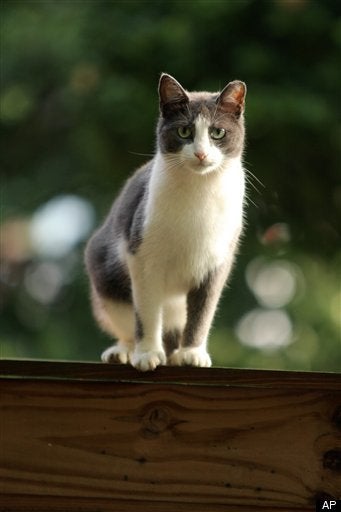
LINCOLN, Neb. (AP) -- A new report by the University of Nebraska at Lincoln that recommends killing feral cats as a way to control the animals -- and includes a primer on how to shoot a cat -- is drawing praise from bird watchers but disdain from cat lovers.
The report began in an undergraduate wildlife management class, with students writing reports on feral cats based on existing research. The students' professor and other UNL researchers then compiled the report from the students' work.
One issue stirring debate is the report's finding that the practice of neutering or spaying homeless cats and returning them to where they were found is ineffective at eliminating feral cat colonies. But the report did find the method useful in reducing the expansion of such colonies.
The trap, neuter and return practice -- also known as TNR -- has gained popularity across the country, with scores of organizations in cities and communities dedicated to the effort.
Stephen Vantassel, a wildlife damage project coordinator who worked on the study, said researchers were aware that some people would be "very offended that we offered any type of lethal control method." But he said the report was written for public consumption and wasn't submitted to any science journals for publication.
The American Bird Conservancy lauded the report, which was posted online, with one official calling it "a must read for any community or government official thinking about what to do about feral cats."
"Not surprisingly, the report validates everything American Bird Conservancy has been saying about the feral cat issue for many years -- namely, TNR doesn't work in controlling feral cat populations," Darin Schroeder, vice president of the Conservation Advocacy for American Bird Conservancy, said Tuesday.
But Phyllis Larsen, a member of a volunteer feral cat management group on the UNL campus, believes the report is flawed. She said her group, Husker Cats, was especially concerned with sections of the report that suggested killing cats, including a segment that stated "proper euthanasia involves a gunshot to the head, chemical injection, or carbon dioxide asphyxiation."
The report later describes the proper way to shoot a cat so that its death is instantaneous.
"We don't believe that killing cats is an appropriate or effective method of feral colony management," Larsen said, adding that the cats help control pest populations on campus by hunting rabbits, squirrels, mice and other rodents.
Larsen also pointed to similar models at other universities including Stanford, Auburn and Texas A&M.
Larsen acknowledged that the cats also kill birds, but argued that the animals are not the sole reason for any decline in songbird numbers. Habitat destruction, herbicides and insecticides, cars, windows and cell towers contribute to the loss of birds, she said.
"I think often, feral cats are used as a scapegoat for other problems that may exist," she said. "We could say, 'Coyotes are killing the rabbits, so let's get rid of coyotes.'"
Larsen and others also take issue with the report's estimate that feral cats' killing of birds costs the U.S. more than $17 billion a year. The report based that number on literature stating bird watchers spend 40 cents per bird observed, hunters spend $216 per bird shot and bird breeders spend $800 per bird released.
"To say that each bird costs $30 ... I have issues with their calculations of the costs," said Margaret Slater, chief epidemiologist with the American Society for the Prevention of Cruelty to Animals, a group that supports TNR programs.
"I'm not sure what that gets you besides making people angry. It cannot be accurate, and it certainly isn't useful," she said.
Slater found the report to be fairly well balanced, but said TNR programs have the advantage of getting community volunteers involved -- an unlikely prospect with programs that trap and euthanize cats.
But some bird advocates say feral cats are an invasive predator that can multiply exponentially, spread disease and kill far more native wildlife than nuisance species.
"The difference is that we've had cardinals and blue jays and blue birds here that have existed for thousands of years, and we've just had cats for a few hundred years," said Bob Johns with American Bird Conservancy. "What's happening now is that the predators are now exploding."
"The problem is just made worse by organizations that try to create feral cat colonies," he said. "When you congregate animals like that, you greatly increase the transmission of disease."
Neutering -- or even feeding -- a feral cat does nothing to curb its instinct to hunt, Johns said, so TNR does nothing to protect native birds and wildlife from feral cats. Perpetuating feral cat colonies also creates a place for cat owners to dump their unwanted pets.
"Virtually every community across the country has a feral cat issue," Johns said. "The reality is that feral cats live a miserable existence that is so difficult that their average life expectancy is one third of a home-owned cat."
The issue of bird vs. cat is far from new. In 1949, for example, Illinois Gov. Adlai Stevenson vetoed a so-call "Cat Bill" that would have penalized people for letting cats outside and allowed for trapping of cats, saying at the time that "the problem of cat versus bird is as old as time."